A Color- and Geometric-Feature-Based Approach for Denoising Three-Dimensional Cultural Relic Point Clouds
Abstract
1. Introduction
2. Related Work
3. Preliminaries
3.1. Graph Signal and Graph Laplacian
3.2. Graph Laplacian Prior
4. The Proposed Method
- Simplification of 3D point cloud: reducing the collection of points to a smaller subset that retains its fundamental topology, thereby reducing the running time of the denoising algorithm;
- Definition of graph signals: interpreting the geometric and color information of the vertices in the input point clouds as graph signals; the geometric information includes geometry coordinates and normal vectors;
- Graph construction and feature graph learning: defining local patches within the point cloud and constructing a graph model with Markovian properties; using a feature graph learning scheme to determine edge weights and solving a maximum a posteriori (MAP) estimation problem with GLR as the signal prior;
- Application of an optimization algorithm to enforce smoothness on the graph signal: we alternately optimize the feature metric matrix M by minimizing the GLR, and M and noisy point cloud are updated alternately until the algorithm converges, and finally, we obtain the clean point cloud.
4.1. Three-Dimensional Point Cloud Simplification
- A bounding box for the point cloud is created. A local kd−tree consisting of 27 cubes of size 3 × 3 × 3 is constructed. The advantage of using this form to organize the points in the point cloud is that the neighborhood points and leaf nodes of the given point can be accurately identified.
- Five feature indexes are calculated to extract features from the point cloud. These five feature indexes include the curvature feature index, the density feature index, the edge feature index, the terrain feature index, and the 3D feature index, denoted as a, b, c, d, and e, respectively. The advantage of this multiple-feature indexing approach is that it can deal with different types of point clouds and discover more intrinsic characteristics of the point cloud.
- The weights of the five feature indexes are calculated using the analytic hierarchy process (AHP) method based on data features. Assuming that is the weight index of feature indexes a, b, c, d, and e, the quantification result of point p is .
- Points with larger z-values are identified as feature points, and points with smaller z-values are identified as non-feature points. All feature points form a simplified point cloud. According to the kd−tree constructed earlier, if there is no feature point in each leaf node, the non-feature point closest to the center of gravity of the node is selected to be added to the simplified point cloud.
4.2. Defining the Graph Signal by Combining Geometry and Color
4.3. Constructing a Graph Based on Self-Similarity Theory
4.4. Graph Feature Learning
4.5. Optimization Algorithm
| Algorithm 1: Optimization algorithm |
| Input: Noisy point cloud , number of patches m, number of nearest neighbors k, |
| number of adjacent patches , trace constraint . |
| Output: Denoised point cloud Y. |
| 1 Initialize Y with ; |
| 2 for iter = 1, 2,… do |
| 3 estimate normal for Y; |
| 4 initialize m empty patches V; |
| 5 find the adjacent patches; |
| 6 initialize M with identity matrix; |
| 7 compute the feature distance for each vertex pair(i,j); |
| 8 solve M; |
| 9 compute adjacency matrix W over all patches; |
| 10 compute Laplacian matrix L; |
| 11 solve Y with (14); |
| 12 end |
5. Experiment Results and Analysis
5.1. Experiment Environment and Dataset
5.2. Evaluation Metrics
5.3. Algorithm Performance Analysis
5.3.1. The Effect of Parameters on Algorithm Performance
5.3.2. Ablation Experiment
5.3.3. Iterations
5.3.4. Robustness
5.4. Comparison with Competing Methods
5.4.1. Subjective Assessment
5.4.2. Objective Assessment
6. Conclusions
Author Contributions
Funding
Institutional Review Board Statement
Data Availability Statement
Acknowledgments
Conflicts of Interest
References
- Liu, Z.; Song, S.; Wang, B.; Gong, W.; Ran, Y.; Hou, X.; Chen, Z.; Li, F. Multispectral LiDAR point cloud highlight removal based on color information. Opt. Express 2022, 30, 28614–28631. [Google Scholar] [CrossRef] [PubMed]
- Li, Z.Q.; Mao, X.Y.; Wang, J.; Guo, Y. Feature-preserving triangular mesh surface denoising: A survey and prospective. J. Comput.-Aided Des. Comput. Graph. 2020, 32, 1–15. [Google Scholar]
- Zhang, W.; Deng, B.; Zhang, J.; Bouaziz, S.; Liu, L. Guided mesh normal filtering. Comput. Graph. Forum 2015, 34, 23–34. [Google Scholar] [CrossRef]
- Li, N.; Yue, S.; Li, Z.; Wang, S.; Wang, H. Adaptive and feature-preserving mesh denoising schemes based on developmental guidance. IEEE Access 2020, 8, 172412–172427. [Google Scholar] [CrossRef]
- Wang, P.-S.; Fu, X.-M.; Liu, Y.; Tong, X.; Liu, S.-L.; Guo, B. Rolling guidance normal filter for geometric processing. ACM Trans. Graph. 2015, 34, 1–9. [Google Scholar] [CrossRef]
- Liu, B.; Cao, J.; Wang, W.; Ma, N.; Li, B.; Liu, L.; Liu, X. Propagated mesh normal filtering. Comput. Graph. 2018, 74, 119–125. [Google Scholar] [CrossRef]
- Huang, H.; Wu, S.; Gong, M.; Cohen-Or, D.; Ascher, U.; Zhang, H. Edge-aware point set resampling. ACM Trans. Graph. 2013, 32, 1–12. [Google Scholar] [CrossRef]
- Zheng, Y.; Li, G.; Wu, S.; Liu, Y.; Gao, Y. Guided point cloud denoising via sharp feature skeletons. Vis. Comput. 2017, 33, 857–867. [Google Scholar] [CrossRef]
- Sun, Y.; Schaefer, S.; Wang, W. Denoising point sets via L0 minimization. Comput. Aided Geom. Des. 2015, 35, 2–15. [Google Scholar] [CrossRef]
- Huang, H.; Li, D.; Zhang, H.; Ascher, U.; Cohen-Or, D. Consolidation of unorganized point clouds for surface reconstruction. ACM Trans. Graph. 2009, 28, 1–7. [Google Scholar] [CrossRef]
- Sarkar, K.; Bernard, F.; Varanasi, K.; Theobalt, C.; Stricker, D. Structured low-rank matrix factorization for point-cloud denoising. In Proceedings of the 2018 International Conference on 3D Vision (3DV), Verona, Italy, 5–8 September 2018; pp. 444–453. [Google Scholar] [CrossRef]
- Li, X.; Zhu, L.; Fu, C.; Heng, P. Non-local low-rank normal filtering for mesh denoising. Comput. Graph. Forum 2018, 37, 155–166. [Google Scholar] [CrossRef]
- Osher, S.; Shi, Z.; Zhu, W. Low dimensional manifold model for image processing. SIAM J. Imaging Sci. 2017, 10, 1669–1690. [Google Scholar] [CrossRef]
- Avron, H.; Sharf, A.; Greif, C.; Cohen-Or, D. L1-sparse reconstruction of sharp point set surfaces. ACM Trans. Graph. 2010, 29, 1–12. [Google Scholar] [CrossRef]
- Zhao, Y.; Li, L.; Shan, X.; Wang, S.; Qin, S.; Wang, H. A L0 denoising algorithm for 3D shapes. J. Comput -Aided Des. Comput. Graph. 2018, 30, 772–777. [Google Scholar]
- Mattei, E.; Castrodad, A. Point cloud denoising via moving RPCA. Comput. Graph. Forum 2017, 36, 123–137. [Google Scholar] [CrossRef]
- Han, X.-F.; Jin, J.S.; Wang, M.-J.; Jiang, W.; Gao, L.; Xiao, L. A review of algorithms for filtering the 3D point cloud. Signal Process. Image Commun. 2017, 57, 103–112. [Google Scholar] [CrossRef]
- Gao, X.; Hu, W.; Tang, J.; Liu, J.; Guo, Z. Optimized skeleton-based action recognition via sparsified graph regression. In Proceedings of the 27th ACM International Conference on Multimedia, New York, NY, USA, 21–25 October 2019; pp. 601–610. [Google Scholar]
- Dinesh, C.; Cheung, G.; Bajic, I.V. Point cloud denoising via feature graph laplacian regularization. IEEE Trans. Image Process. 2020, 29, 4143–4158. [Google Scholar] [CrossRef] [PubMed]
- Shang, X.; Ye, R.; Feng, H.; Jiang, X. Robust Feature Graph for Point Cloud Denoising. In Proceedings of the 7th International Conference on Communication, Image and Signal Processing (CCISP), Chengdu, China, 18–20 November 2022. [Google Scholar]
- Egilmez, H.E.; Pavez, E.; Ortega, A. Graph learning from data under laplacian and structural constraints. IEEE J. Sel. Top. Signal Process. 2017, 11, 825–841. [Google Scholar] [CrossRef]
- Jiang, B.; Zhang, Z.Y.; Lin, D.D.; Tang, J.; Luo, B. Semi-supervised learning with graph learning-convolutional networks. In Proceedings of the International Conference on Computer Vision and Pattern Recognition (CVPR), Long Beach, CA, USA, 15–20 June 2019. [Google Scholar]
- Hu, W.; Gao, X.; Cheung, G.; Guo, Z. Feature graph learning for 3D point cloud denoising. IEEE Trans. Signal Process. 2020, 68, 2841–2856. [Google Scholar] [CrossRef]
- Hu, W.; Hu, Q.; Wang, Z.; Gao, X. Dynamic point cloud denoising via manifold-to-manifold distance. IEEE Trans. Image Process. 2021, 30, 6168–6183. [Google Scholar] [CrossRef]
- Hu, W.; Pang, J.; Liu, X.; Tian, D.; Lin, C.W.; Vetro, A. Graph signal processing for geometric data and beyond: Theory and applications. IEEE Trans. Multimed. 2022, 24, 3961–3977. [Google Scholar] [CrossRef]
- Zeng, J.; Cheung, G.; Ng, M.; Pang, J.; Yang, C. 3D point cloud denoising using graph laplacian regularization of a low dimensional manifold model. IEEE Trans. Image Process. 2020, 29, 3474–3489. [Google Scholar] [CrossRef]
- Wang, J.; Huang, J.; Wang, F.L.; Wei, M.; Xie, H.; Qin, J. Data-driven geometry-recovering mesh denoising. Comput. Des. 2019, 114, 133–142. [Google Scholar] [CrossRef]
- Zhao, W.B.; Liu, X.M.; Zhao, Y.S.; Fan, X.P.; Zhao, D.B. NormalNet: Learning based guided normal filtering for mesh denoising. arXiv 2019, arXiv:1903.04015v2. Available online: https://arxiv.org/abs/1903.04015v2 (accessed on 4 November 2019).
- Li, Z.; Pan, W.; Wang, S.; Tang, X.; Hu, H. A point cloud denoising network based on manifold in an unknown noisy environment. Infrared Phys. Technol. 2023, 132, 104735. [Google Scholar] [CrossRef]
- Huang, A.; Xie, Q.; Wang, Z.; Lu, D.; Wei, M.; Wang, J. MODNet: Multi-offset point cloud denoising network customized for multi-scale patches. Comput. Graph. Forum 2022, 41, 109–119. [Google Scholar] [CrossRef]
- Cattai, T.; Delfino, A.; Scarano, G.; Colonnese, S. VIPDA: A visually driven point cloud denoising algorithm based on anisotropic point cloud filtering. Front. Signal Process. 2022, 2, 842570. [Google Scholar] [CrossRef]
- Hu, X.; Wei, X.; Sun, J. A noising-denoising framework for point cloud upsampling via normalizing flows. Pattern Recognit. J. Pattern Recognit. Soc. 2023, 140, 109569. [Google Scholar] [CrossRef]
- Liu, Y.; Sheng, H.K. A single-stage point cloud cleaning network for outlier removal and denoising. Pattern Recognit. 2023, 138, 109366. [Google Scholar] [CrossRef]
- Shuman, D.I.; Narang, S.K.; Frossard, P.; Ortega, A.; Vandergheynst, P. The emerging field of signal processing on graphs: Extending high-dimensional data analysis to networks and other irregular domains. IEEE Signal Process. Mag. 2013, 30, 83–98. [Google Scholar] [CrossRef]
- Li, X.; Han, J.; Yuan, Q.; Zhang, Y.; Fu, Z.; Zou, M.; Huang, Z. FEUSNet: Fourier Embedded U-Shaped Network for Image Denoising. Entropy 2023, 25, 1418. [Google Scholar] [CrossRef]
- Li, R.Z.; Yang, M.; Ran, Y.; Zhang, H.H.; Jing, J.F.; Li, P.F. Point cloud denoising and simplification algorithm based on method library. Laser Optoelectron. Prog. 2018, 55, 251–257. [Google Scholar]
- Liu, Y.; Sun, Y. Laser point cloud denoising based on principal component analysis and surface fitting. Laser Technol. 2020, 44, 103–108. [Google Scholar]
- Yang, D.; Sun, J. BM3D-Net: A convolutional neural network for transform-domain collaborative filtering. IEEE Signal Process. Lett. 2017, 25, 55–59. [Google Scholar] [CrossRef]
- Wei, X.; van Gorp, H.; Carabarin, L.G.; Freedman, D.; Eldar, Y.C.; van Sloun, R.J.G. Image denoising with deep unfolding and normalizing flows. In Proceedings of the IEEE International Conference on Acoustics, Speech and Signal Processing (ICASSP), Singapore, 23–27 May 2022. [Google Scholar]
- Wei, X.; Van Gorp, H.; Gonzalez-Carabarin, L.; Freedman, D.; Eldar, Y.C.; van Sloun, R.J. Deep unfolding with normalizing flow priors for inverse problems. IEEE Trans. Signal Process. 2022, 70, 2962–2971. [Google Scholar] [CrossRef]
- Dutta, S.; Basarab, A.; Georgeot, B.; Kouame, D. Quantum mechanics-based signal and image representation: Application to denoising. IEEE Open J. Signal Process. 2021, 2, 190–206. [Google Scholar] [CrossRef]
- Dutta, S.; Basara, A.; Georgeot, B.; Kouamé, D. A novel image denoising algorithm using concepts of quantum many-body theory. Signal Process. 2022, 201, 108690. [Google Scholar] [CrossRef]
- Shi, Z.; Xu, W.; Meng, H. A point cloud simplification algorithm based on weighted feature indexes for 3D scanning sensors. Sensors 2022, 22, 7491. [Google Scholar] [CrossRef]
- Pasqualotto, G.; Zanuttigh, P.; Cortelazzo, G.M. Combining color and shape descriptors for 3D model retrieval. Signal Process. Image Commun. 2013, 28, 608–623. [Google Scholar] [CrossRef]
- Musicco, A.; Galantucci, R.A.; Bruno, S.; Verdoscia, C.; Fatiguso, F. Automatic point cloud segmentation for the detection of alterations on historical buildings through an unsupervised and clustering-based machine learing approch. ISPRS Ann. Photogramm. Remote Sens. Spat. Inf. Sci. 2021, 2, 129–136. [Google Scholar] [CrossRef]
- Vinodkumar, P.K.; Karabulut, D.; Avots, E.; Ozcinar, C.; Anbarjafari, G. A Survey on Deep Learning Based Segmentation, Detection and Classification for 3D Point Clouds. Entropy 2023, 25, 635. [Google Scholar] [CrossRef]
- Irfan, A.M.; Magli, E. Exploiting color for graph-based 3D point cloud denoising. J. Vis. Commun. Image Represent. 2021, 75, 103027. [Google Scholar] [CrossRef]
- Rosman, G.; Dubrovina, A.; Kimmel, R. Patch-collaborative spectral point-cloud denoising. Comput. Graph. Forum 2013, 32, 1–12. [Google Scholar] [CrossRef]
- Barkalov, K.; Shtanyuk, A.; Sysoyev, A. A Fast kNN Algorithm Using Multiple Space-Filling Curves. Entropy 2022, 24, 767. [Google Scholar] [CrossRef] [PubMed]
- Miranda-González, A.A.; Rosales-Silva, A.J.; Mújica-Vargas, D.; Escamilla-Ambrosio, P.J.; Gallegos-Fune, F.J.; Vianney-Kinani, J.M.; Velázquez-Lozada, E.; Pérez-Hernández, L.M.; Lozano-Vázquez, L.V. Denoising Vanilla Autoencoder for RGB and GS Images with Gaussian Noise. Entropy 2023, 25, 1467. [Google Scholar] [CrossRef] [PubMed]
- De Gregorio, J.; Sánchez, D.; Toral, R. Entropy Estimators for Markovian Sequences: A Comparative Analysis. Entropy 2024, 26, 79. [Google Scholar] [CrossRef] [PubMed]
- Paige, C.; Saunders, M. LSQR: An Algorithm for Sparse Linear Equations and Sparse Least Squares. ACM Trans. Math. Softw. 1982, 8, 43–71. [Google Scholar] [CrossRef]
- Parikh, N.; Boyd, S. Proximal Algorithms. Found. Trends Optim. 2013, 1, 123–231. [Google Scholar]
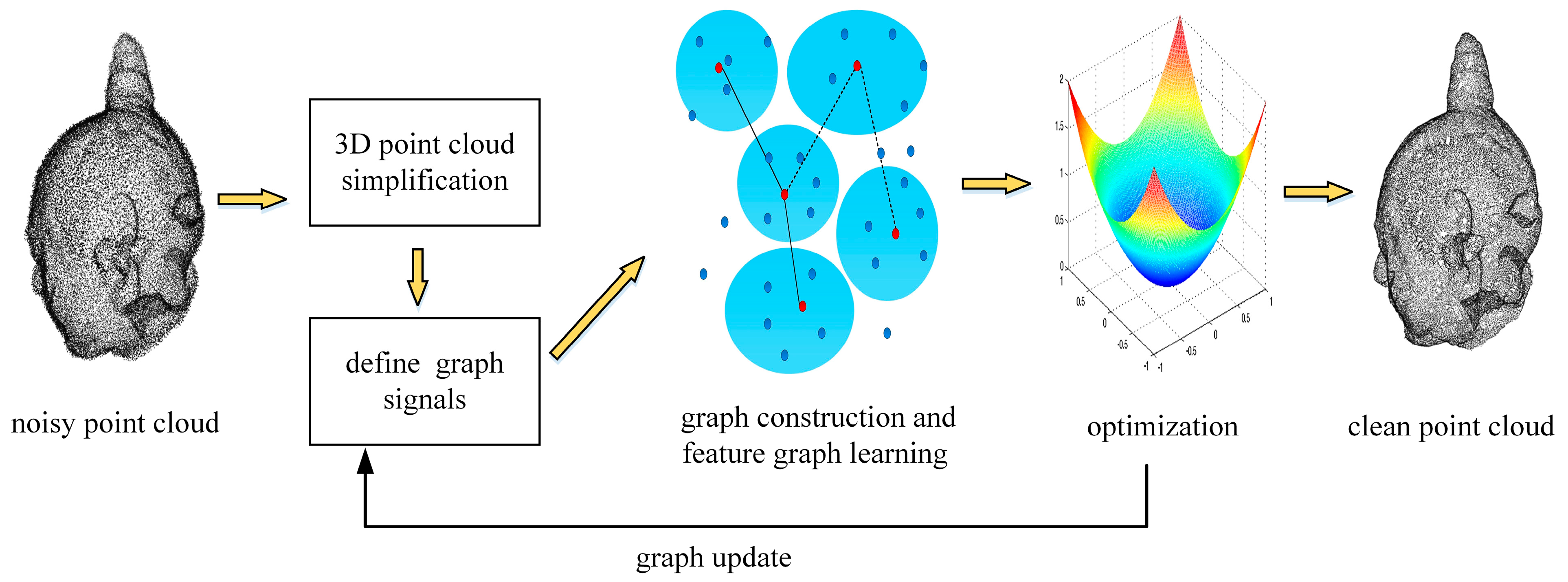
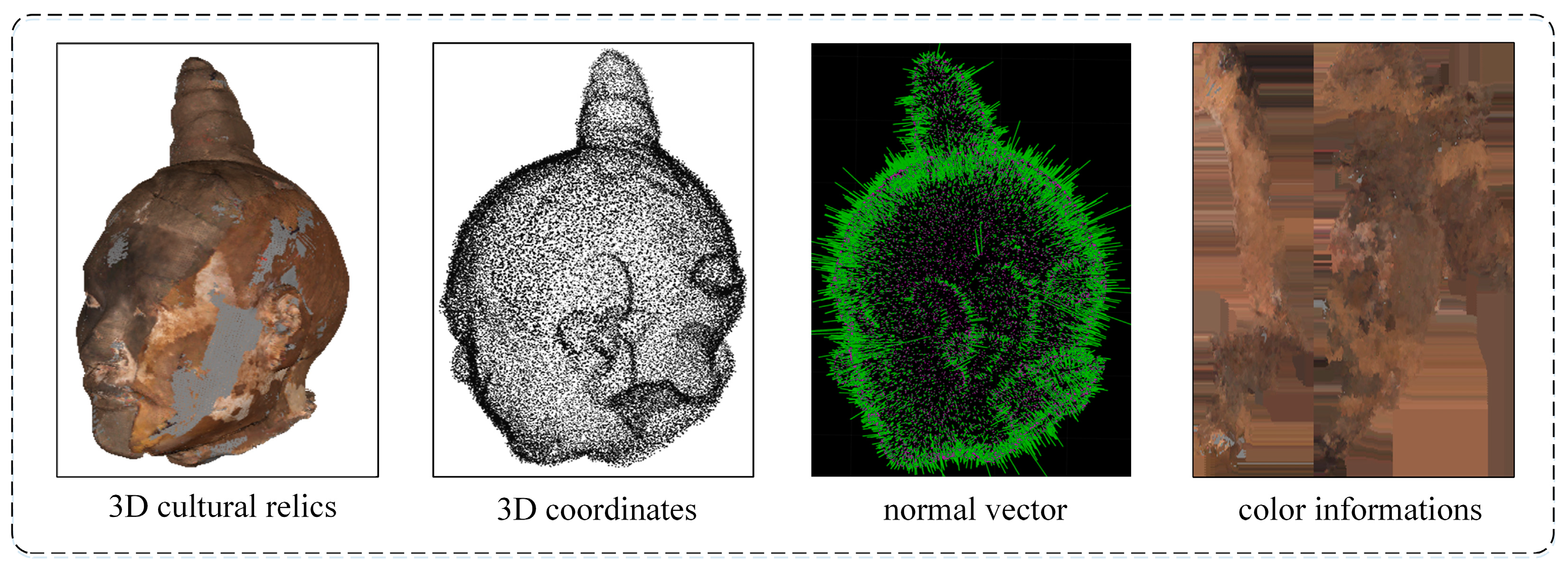
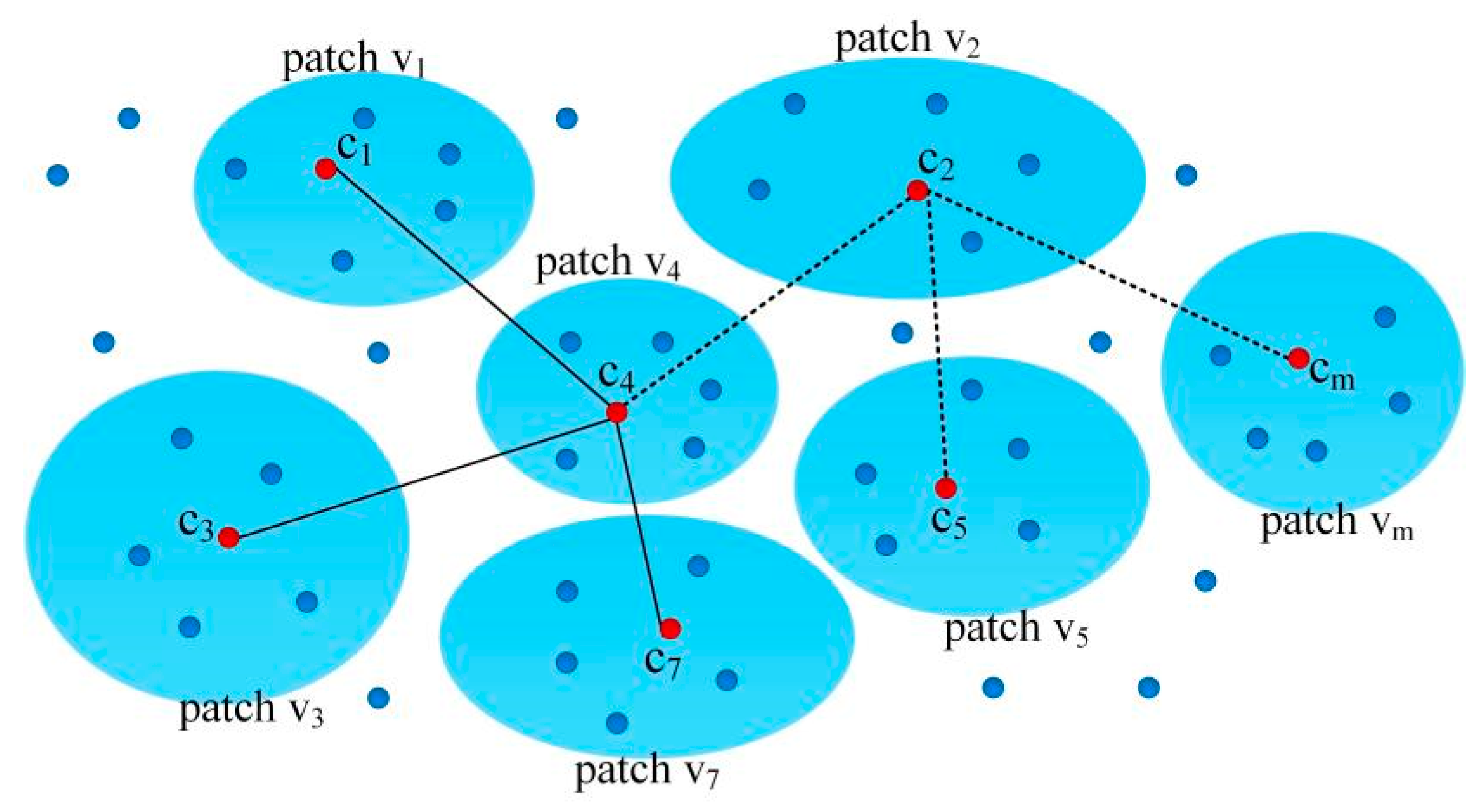

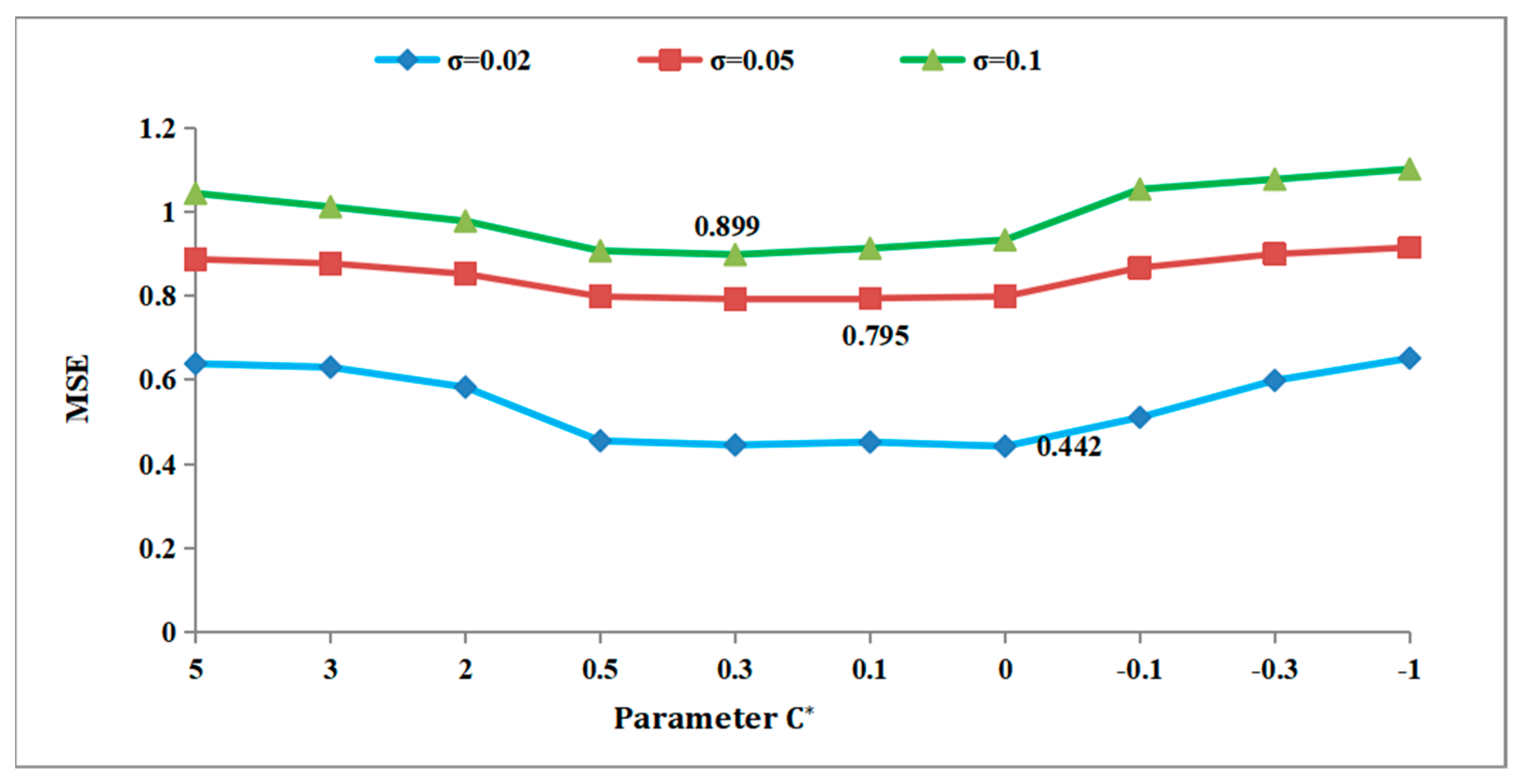
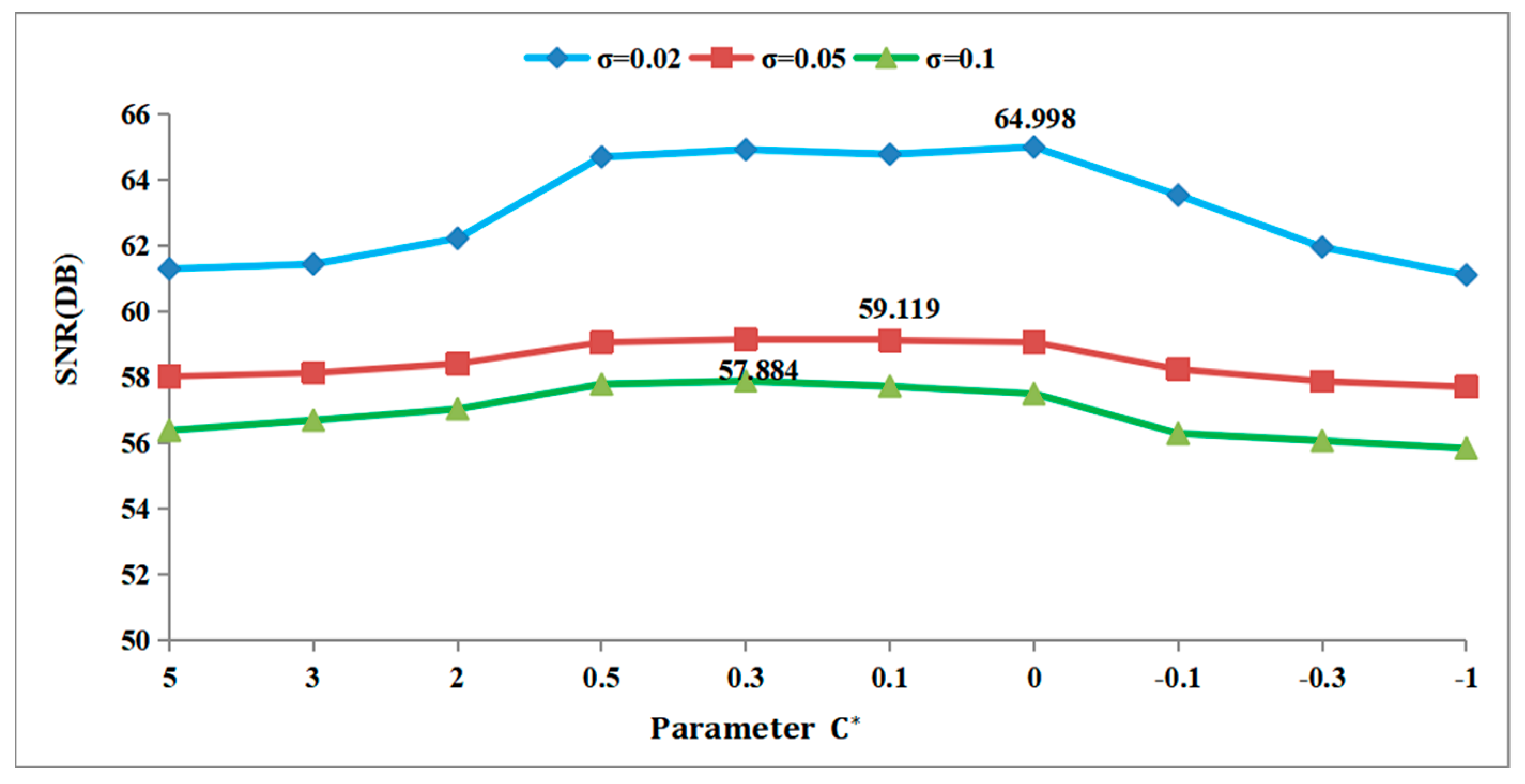





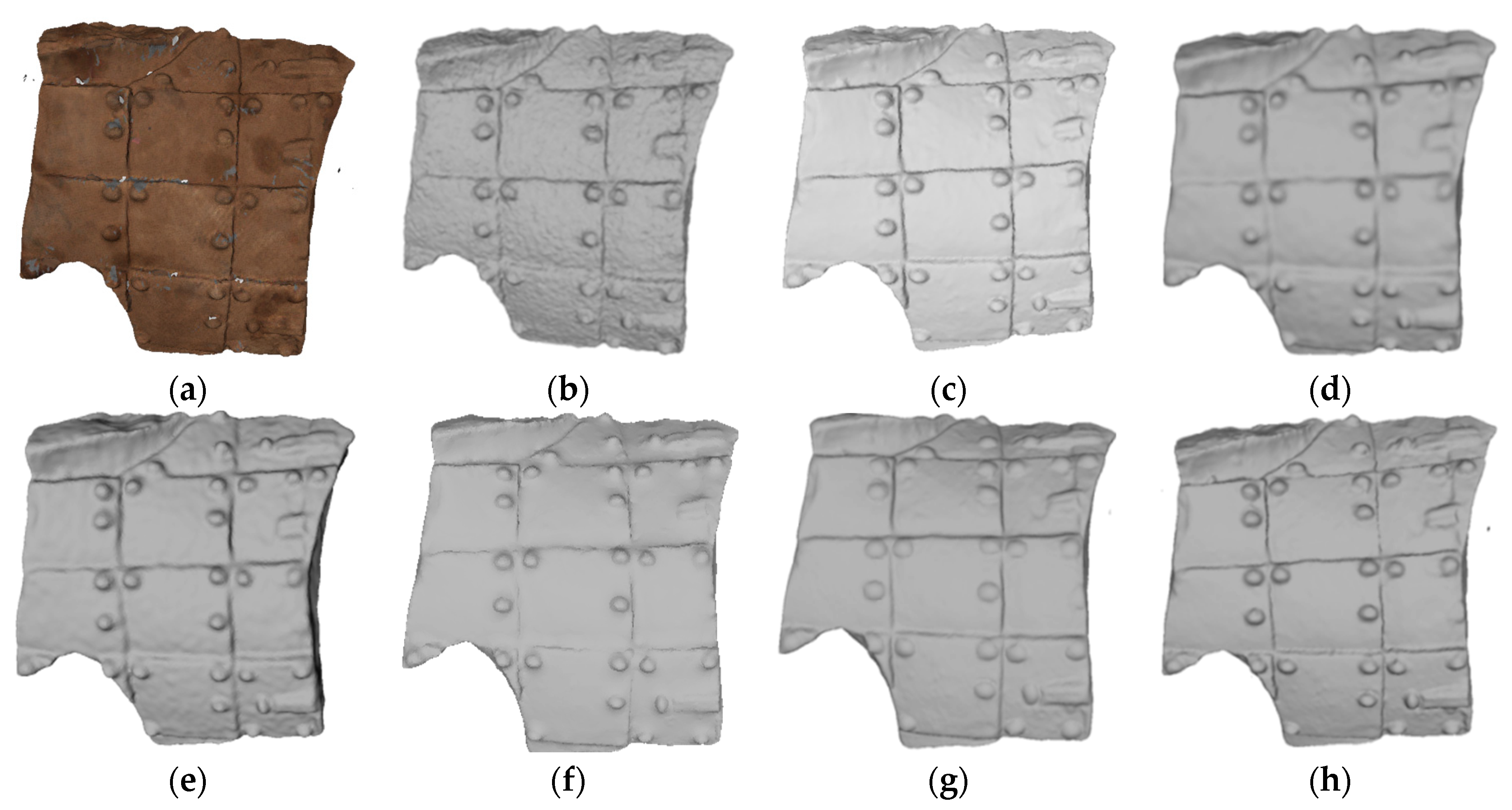
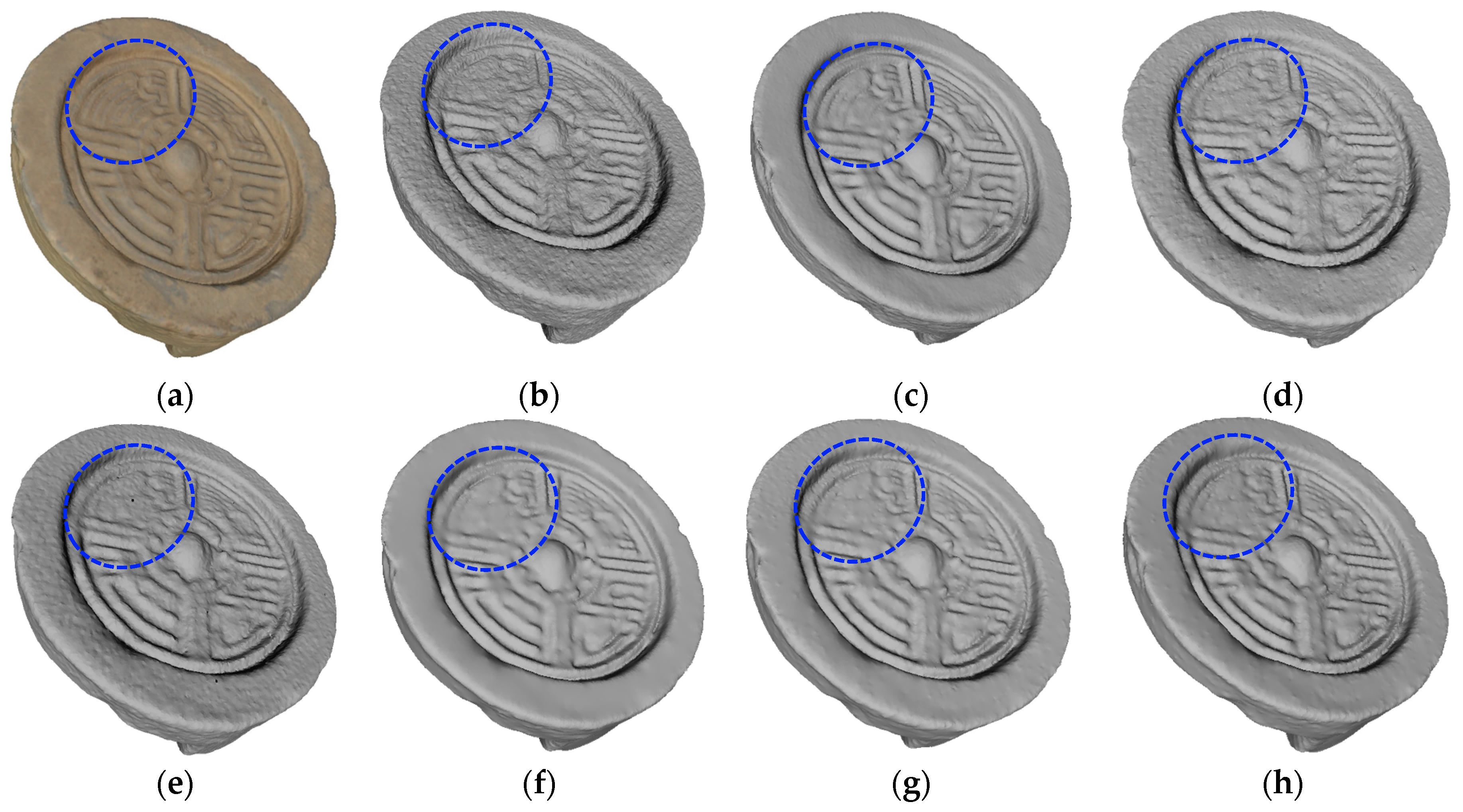
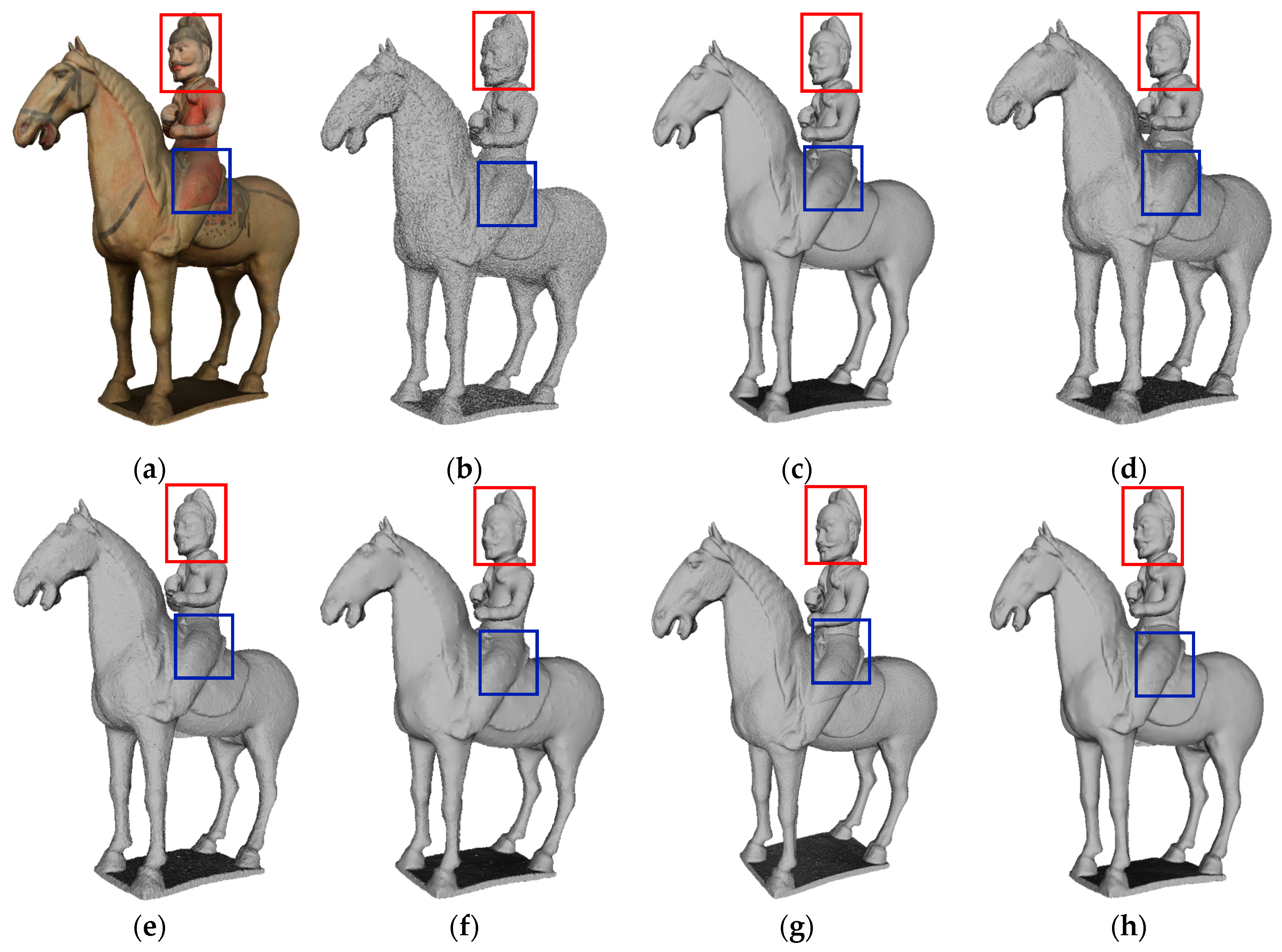


| Parameter | Down Sampling Rate | The Number of Points in the Patches | The Number of Nearest Neighbors of a Patch | |
|---|---|---|---|---|
| Value | 0.3 | 9 | 10 | 3 |
| Method | σ | Points | SNR (DB) | MSE | Iterations | Running Time (s) |
|---|---|---|---|---|---|---|
| Only geometry | 0.02 | 58,380 | 60.66 | 0.61 | 4 | 172 |
| Geometry + color | 63.98 | 0.50 | 4 | 171 | ||
| Only geometry | 0.05 | 58,380 | 61.91 | 0.84 | 10 | 864 |
| Geometry + color | 62.14 | 0.72 | 11 | 870 | ||
| Only geometry | 0.1 | 58,380 | 59.50 | 1.07 | 46 | 3985 |
| Geometry + color | 62.03 | 0.81 | 49 | 4011 | ||
| Only geometry | 0.2 | 58,380 | 52.98 | 2.05 | 100 | 8884 |
| Geometry + color | 54.02 | 1.90 | 106 | 9003 |
| Method | σ | Points | SNR(DB) | MSE | Iterations | Running Time (s) |
|---|---|---|---|---|---|---|
| Geometry + color | 0.02 | 58,380 | 63.98 | 0.50 | 4 | 171 |
| Geometry + color + simplification | 30,000 | 64.12 | 0.55 | 1 | 42 | |
| Geometry + color | 0.05 | 58,380 | 62.14 | 0.72 | 11 | 870 |
| Geometry + color + simplification | 30,000 | 61.98 | 0.76 | 2 | 139 | |
| Geometry + color | 0.1 | 58,380 | 62.03 | 0.81 | 49 | 4011 |
| Geometry + color + simplification | 30,000 | 59.96 | 0.96 | 8 | 293 | |
| Geometry + color | 0.2 | 58,380 | 54.02 | 1.90 | 106 | 9003 |
| Geometry + color + simplification | 30,000 | 51.99 | 1.89 | 29 | 1104 |
| Data | σ | MRPCA | LR | [19] | [31] | [24] | Our Method |
|---|---|---|---|---|---|---|---|
| G10-52 | 0.02 | 0.697 | 0.760 | 0.684 | 0.704 | 0.650 | 0.630 |
| G10-46-5 | 0.02 | 0.885 | 0.955 | 0.879 | 0.906 | 0.827 | 0.801 |
| G3-I-C-94 | 0.02 | 0.797 | 0.842 | 0.774 | 0.801 | 0.746 | 0.769 |
| G10-11-43(47) | 0.02 | 0.658 | 0.678 | 0.633 | 0.659 | 0.613 | 0.573 |
| Q002789 | 0.02 | 0.251 | 0.247 | 0.297 | 0.231 | 0.223 | 0.198 |
| Q003418 | 0.02 | 0.503 | 0.515 | 0.472 | 0.497 | 0.421 | 0.432 |
| H73 | 0.02 | 0.390 | 0.387 | 0.350 | 0.356 | 0.335 | 0.305 |
| H80 | 0.02 | 0.567 | 0.581 | 0.549 | 0.545 | 0.534 | 0.521 |
| Average | 0.594 | 0.621 | 0.580 | 0.587 | 0.544 | 0.529 | |
| G10-52 | 0.03 | 0.801 | 0.826 | 0.799 | 0.819 | 0.759 | 0.733 |
| G10-46-5 | 0.03 | 1.000 | 1.031 | 0.964 | 1.001 | 0.939 | 0.909 |
| G3-I-C-94 | 0.03 | 0.940 | 0.948 | 0.899 | 0.921 | 0.873 | 0.826 |
| G10-11-43(47) | 0.03 | 0.719 | 0.730 | 0.687 | 0.713 | 0.659 | 0.642 |
| Q002789 | 0.03 | 0.304 | 0.315 | 0.279 | 0.281 | 0.274 | 0.270 |
| Q003418 | 0.03 | 0.579 | 0.576 | 0.561 | 0.570 | 0.554 | 0.542 |
| H73 | 0.03 | 0.375 | 0.386 | 0.368 | 0.360 | 0.354 | 0.346 |
| H80 | 0.03 | 0.634 | 0.641 | 0.639 | 0.619 | 0.624 | 0.620 |
| Average | 0.658 | 0.670 | 0.638 | 0.648 | 0.619 | 0.601 | |
| G10-52 | 0.04 | 0.948 | 0.945 | 0.915 | 0.930 | 0.872 | 0.820 |
| G10-46-5 | 0.04 | 1.034 | 1.079 | 1.027 | 1.014 | 1.042 | 0.961 |
| G3-I-C-94 | 0.04 | 1.032 | 1.045 | 0.984 | 1.023 | 0.987 | 0.992 |
| G10-11-43(47) | 0.04 | 0.741 | 0.734 | 0.717 | 0.722 | 0.699 | 0.641 |
| Q002789 | 0.04 | 0.324 | 0.310 | 0.298 | 0.291 | 0.283 | 0.279 |
| Q003418 | 0.04 | 0.649 | 0.655 | 0.634 | 0.627 | 0.618 | 0.609 |
| H73 | 0.04 | 0.412 | 0.420 | 0.421 | 0.428 | 0.431 | 0.447 |
| H80 | 0.04 | 0.749 | 0.740 | 0.759 | 0.733 | 0.711 | 0.723 |
| Average | 0.736 | 0.741 | 0.719 | 0.721 | 0.705 | 0.684 | |
| G10-52 | 0.05 | 0.943 | 1.157 | 0.911 | 0.921 | 0.907 | 0.857 |
| G10-46-5 | 0.05 | 1.167 | 1.370 | 1.143 | 1.110 | 1.177 | 1.009 |
| G3-I-C-94 | 0.05 | 1.097 | 1.265 | 1.024 | 1.057 | 1.103 | 0.983 |
| G10-11-43(47) | 0.05 | 0.867 | 0.948 | 0.833 | 0.802 | 0.756 | 0.709 |
| Q002789 | 0.05 | 0.331 | 0.333 | 0.321 | 0.325 | 0.312 | 0.301 |
| Q003418 | 0.05 | 0.729 | 0.733 | 0.702 | 0.711 | 0.697 | 0.687 |
| H73 | 0.05 | 0.533 | 0.557 | 0.519 | 0.524 | 0.505 | 0.495 |
| H80 | 0.05 | 0.802 | 0.823 | 0.785 | 0.799 | 0.791 | 0.779 |
| Average | 0.809 | 0.898 | 0.780 | 0.781 | 0.781 | 0.728 | |
| G10-52 | 0.1 | 1.158 | 1.188 | 1.199 | 1.149 | 1.045 | 0.941 |
| G10-46-5 | 0.1 | 1.786 | 1.797 | 1.667 | 1.736 | 1.594 | 1.494 |
| G3-I-C-94 | 0.1 | 1.433 | 1.453 | 1.338 | 1.421 | 1.281 | 1.105 |
| G10-11-43(47) | 0.1 | 1.185 | 1.195 | 1.164 | 1.177 | 1.152 | 0.912 |
| Q002789 | 0.1 | 0.425 | 0.439 | 0.415 | 0.411 | 0.409 | 0.401 |
| Q003418 | 0.1 | 0.749 | 0.750 | 0.736 | 0.741 | 0.730 | 0.724 |
| H73 | 0.1 | 0.551 | 0.536 | 0.534 | 0.540 | 0.528 | 0.526 |
| H80 | 0.1 | 1.103 | 1.101 | 1.098 | 1.067 | 1.076 | 0.997 |
| Average | 1.049 | 1.057 | 1.019 | 1.030 | 0.977 | 0.888 | |
| Data | σ | MRPCA | LR | [19] | [31] | [24] | Our Method |
|---|---|---|---|---|---|---|---|
| G10-52 | 0.02 | 60.10 | 59.53 | 59.86 | 60.99 | 61.29 | 62.33 |
| G10-46-5 | 0.02 | 66.84 | 65.79 | 66.12 | 64.82 | 67.73 | 67.95 |
| G3-I-C-94 | 0.02 | 61.03 | 58.55 | 61.85 | 61.42 | 62.28 | 62.24 |
| G10-11-43(47) | 0.02 | 66.02 | 65.88 | 66.57 | 65.81 | 67.21 | 67.23 |
| Q002789 | 0.02 | 57.49 | 57.43 | 58.02 | 57.87 | 58.26 | 61.23 |
| Q003418 | 0.02 | 62.68 | 62.70 | 63.74 | 66.34 | 64.54 | 66.21 |
| H73 | 0.02 | 67.86 | 68.15 | 70.23 | 69.31 | 70.70 | 72.23 |
| H80 | 0.02 | 71.01 | 69.43 | 71.26 | 71.85 | 73.22 | 73.22 |
| Average | 64.13 | 63.43 | 64.71 | 64.80 | 65.65 | 66.58 | |
| G10-52 | 0.03 | 58.90 | 58.47 | 59.03 | 58.48 | 59.68 | 59.78 |
| G10-46-5 | 0.03 | 65.57 | 64.59 | 65.55 | 64.95 | 66.34 | 66.45 |
| G3-I-C-94 | 0.03 | 59.85 | 59.41 | 59.88 | 59.52 | 61.65 | 61.49 |
| G10-11-43(47) | 0.03 | 65.54 | 65.46 | 66.02 | 65.83 | 66.51 | 66.99 |
| Q002789 | 0.03 | 54.23 | 53.12 | 56.89 | 56.12 | 57.59 | 59.31 |
| Q003418 | 0.03 | 60.43 | 60.95 | 61.98 | 62.35 | 62.13 | 62.87 |
| H73 | 0.03 | 67.85 | 68.15 | 69.85 | 69.87 | 70.12 | 73.01 |
| H80 | 0.03 | 69.27 | 68.99 | 70.56 | 70.04 | 71.23 | 72.01 |
| Average | 62.71 | 62.39 | 63.72 | 63.40 | 64.41 | 65.24 | |
| G10-52 | 0.04 | 57.79 | 57.37 | 57.64 | 57.93 | 58.25 | 58.41 |
| G10-46-5 | 0.04 | 64.87 | 64.19 | 64.60 | 64.77 | 65.40 | 65.51 |
| G3-I-C-94 | 0.04 | 58.80 | 58.77 | 58.95 | 59.01 | 59.37 | 59.32 |
| G10-11-43(47) | 0.04 | 65.60 | 64.92 | 65.22 | 65.08 | 66.03 | 66.13 |
| Q002789 | 0.04 | 55.46 | 56.12 | 56.13 | 56.98 | 57.26 | 58.72 |
| Q003418 | 0.04 | 58.57 | 58.66 | 59.02 | 59.54 | 60.03 | 61.23 |
| H73 | 0.04 | 66.72 | 66.39 | 67.98 | 67.55 | 68.31 | 69.84 |
| H80 | 0.04 | 66.54 | 66.23 | 66.75 | 67.12 | 67.00 | 67.88 |
| Average | 61.79 | 61.58 | 62.04 | 62.25 | 62.71 | 63.38 | |
| G10-52 | 0.05 | 57.14 | 56.87 | 56.75 | 57.08 | 57.82 | 57.96 |
| G10-46-5 | 0.05 | 63.78 | 63.34 | 63.46 | 63.57 | 63.70 | 63.77 |
| G3-I-C-94 | 0.05 | 58.45 | 57.67 | 58.25 | 58.13 | 59.05 | 59.11 |
| G10-11-43(47) | 0.05 | 64.27 | 63.33 | 64.36 | 64.56 | 65.07 | 65.11 |
| Q002789 | 0.05 | 54.64 | 55.03 | 56.01 | 55.46 | 56.87 | 56.99 |
| Q003418 | 0.05 | 56.44 | 55.85 | 56.77 | 57.03 | 57.98 | 58.34 |
| H73 | 0.05 | 66.75 | 66.23 | 67.41 | 67.06 | 66.58 | 67.56 |
| H80 | 0.05 | 63.96 | 63.18 | 64.85 | 64.86 | 64.23 | 65.01 |
| Average | 60.68 | 60.19 | 60.98 | 60.97 | 61.41 | 61.73 | |
| G10-52 | 0.1 | 54.85 | 54.93 | 54.85 | 54.93 | 55.00 | 55.09 |
| G10-46-5 | 0.1 | 59.16 | 59.33 | 59.15 | 59.22 | 59.22 | 59.30 |
| G3-I-C-94 | 0.1 | 55.52 | 55.29 | 55.50 | 55.51 | 55.52 | 55.60 |
| G10-11-43(47) | 0.1 | 59.55 | 59.43 | 59.54 | 59.48 | 59.57 | 59.66 |
| Q002789 | 0.1 | 52.45 | 52.32 | 54.51 | 53.56 | 53.77 | 54.90 |
| Q003418 | 0.1 | 53.54 | 53.85 | 53.67 | 53.30 | 53.82 | 53.14 |
| H73 | 0.1 | 63.57 | 63.33 | 63.47 | 63.06 | 63.83 | 62.62 |
| H80 | 0.1 | 60.86 | 60.23 | 61.77 | 61.66 | 61.29 | 62.34 |
| Average | 57.44 | 57.34 | 57.81 | 57.59 | 57.75 | 57.83 | |
Disclaimer/Publisher’s Note: The statements, opinions and data contained in all publications are solely those of the individual author(s) and contributor(s) and not of MDPI and/or the editor(s). MDPI and/or the editor(s) disclaim responsibility for any injury to people or property resulting from any ideas, methods, instructions or products referred to in the content. |
© 2024 by the authors. Licensee MDPI, Basel, Switzerland. This article is an open access article distributed under the terms and conditions of the Creative Commons Attribution (CC BY) license (https://creativecommons.org/licenses/by/4.0/).
Share and Cite
Gao, H.; Wang, H.; Zhao, S. A Color- and Geometric-Feature-Based Approach for Denoising Three-Dimensional Cultural Relic Point Clouds. Entropy 2024, 26, 319. https://doi.org/10.3390/e26040319
Gao H, Wang H, Zhao S. A Color- and Geometric-Feature-Based Approach for Denoising Three-Dimensional Cultural Relic Point Clouds. Entropy. 2024; 26(4):319. https://doi.org/10.3390/e26040319
Chicago/Turabian StyleGao, Hongjuan, Hui Wang, and Shijie Zhao. 2024. "A Color- and Geometric-Feature-Based Approach for Denoising Three-Dimensional Cultural Relic Point Clouds" Entropy 26, no. 4: 319. https://doi.org/10.3390/e26040319
APA StyleGao, H., Wang, H., & Zhao, S. (2024). A Color- and Geometric-Feature-Based Approach for Denoising Three-Dimensional Cultural Relic Point Clouds. Entropy, 26(4), 319. https://doi.org/10.3390/e26040319




